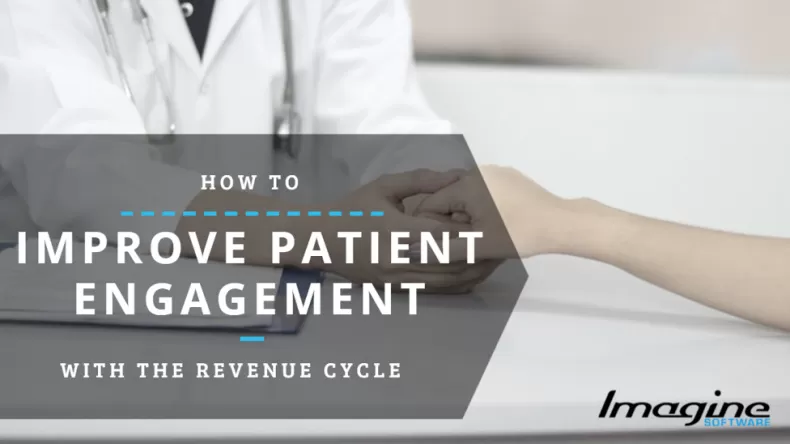It’s time to say goodbye to fee-for-service models of patient care! The healthcare world is taking a giant leap towards value-based care, and with it, the way medical practices are paid for their work. The days of quantity over quality are coming to an end. No longer will practices be reimbursed by how many patients they encounter, despite health outcomes or costs associated. Now, providers must shift focus to engaging patients in their care. Below are some tips on how to improve patient engagement in healthcare, along with the top capabilities to look for in your next patient engagement software.

Patient Engagement Definitions
Patient engagement is a term often used to describe a strategy for promoting positive patient behavior through a more active means of managing one’s health. Similarly, the term, “triple aim,” describes patients taking a more active role in their healthcare in partnership with a provider for improving outcomes, providing better patient care, and lowering costs.
In a study by NORC at the University of Chicago, 57% of patients were surprised by a medical bill that they thought would be covered by their payer. Due to the complexity of the healthcare system, patients often lack a complete understanding of the care they receive, not knowing all the contributing factors in the cost of care. As a result, those that receive care are often taken aback by the final medical bill they receive, leading to additional time and resources the medical practice must dedicate to helping patients understand their financial responsibility.
For most, the decision on what care they receive depends entirely on the associated costs. For example, a patient with knee pain may opt in for a knee replacement and several months of rehabilitation despite the related cost. Other patients elect to address the issue with a less costly option like diet and weight loss. However, a factor that often leads patients to ignore cost is the perception of the quality of the care when compared to a less expensive alternative. This is where patient engagement comes in.
Strategies for How to Improve Patient Engagement in Healthcare
In a 2018 Deloitte consumer engagement survey, 58% of patients felt that doctors should explain treatment costs with them before decisions on treatment are made. For a patient to be truly engaged, they must first receive the necessary information to make an informed decision. This information includes a full cost estimate of the procedure in relation to the care they will receive. At the same time, healthcare organizations must have patient engagement strategies in place in the form of processes and/or software to assess which services are within a patient’s financial means:
- Receive the necessary pre-authorization from payers.
- Price transparency of patient responsible charge
- Coverage discovery and alternative payment methods, as needed
- Tools and payment plans for patients to more easily manage their financial responsibility.
Imagine a future in which consumers are empowered with more options for managing their healthcare costs.
LEARN ABOUT PATIENT PAYMENT SOLUTIONS
Benefits of Patient Engagement
It is ultimately the patient’s choice as to what care they receive. When searching for a new healthcare provider, patients are most interested in coverage, cost and convenience. As a healthcare provider, it’s your job to make it easy to find out if procedures are covered by their insurance. Be transparent about costs. Finally, provide an easy method for patients to cover the costs of their elected procedure.
Patient engagement creates the opportunity for more coordinated care between physicians, clinicians, and their patients. Remote care and personalized scheduling allow patients with chronic conditions to be monitored more closely. This way, both parties are interacting in a meaningful way and the patient is also saving time in preparation for future encounters.
For providers, you’re saving yourselves additional administrative burden by enabling patients to manage their own financial responsibility outside of business hours. With the right tools, payment scheduling, communication and ordering are automated, creating sleeker daily operations. Thus, administrators and staff have more time to dedicate towards high-priority tasks.
When engaged, patients are empowered to take the reins on the care they receive, making it easier for patients to be involved in their own care, improving outcomes, and ultimately forming long-term relationships. At the end of the day, that’s what it’s all about – building long-term relationships with your patients.
Top Patient Engagement Software Capabilities
More providers are searching for solutions to meet the needs of their patients while increasing workflow efficiency and meeting health quality measures. To that ends, here are a few capabilities to consider when evaluating patient engagement software:
- Streamline workflow to assess eligibility and prior authorization - The American Medical Association contends prior authorization can create significant barriers by delaying the start or continuation of necessary treatment. One solution includes the use of electronic transfers to quickly submit required authorization materials, reducing administrative burden and deliver treatment to patients faster.
- A way to estimate patient responsibility - 46% of younger patients state they would be in a better position to handle the financial responsibility of healthcare if they received a cost estimate at the point-of-service. A patient responsibility estimator informs patients of their responsibility and educates them on any hidden costs associated with a procedure.
- An automated process for discovering unknown coverage - Every dollar discovered before a procedure is one providers aren’t spending time and resources to collect in the back-end. ImagineDiscoveryTM Identifies payers early in the revenue cycle to reduce bad debt and improve patient satisfaction.
- A portal for collecting online payments - ImaginePayTM is a secure and mobile-friendly payment portal for patients to make medical payments online. The system can be set up for manual payments every month or for payments to be automatically drafted from a patient’s account.